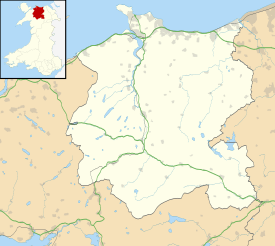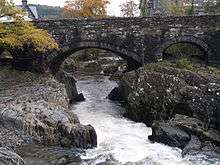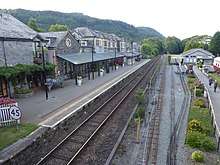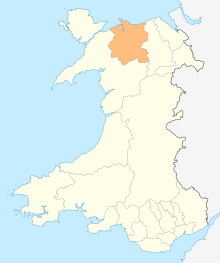Betws-y-Coed
Betws-y-coed (Welsh pronunciation: [ˈbɛtʊs ə ˈkɔɨd]) ![]()
| Betws-y-coed | |
|---|---|
 Afon Llugwy | |
 Betws-y-coed Location within Conwy | |
| Population | 564 (2011) |
| OS grid reference | SH795565 |
| Community |
|
| Principal area |
|
| Ceremonial county | |
| Country | Wales |
| Sovereign state | United Kingdom |
| Post town | BETWS-Y-COED |
| Postcode district | LL24 |
| Dialling code | 01690 |
| Police | North Wales |
| Fire | North Wales |
| Ambulance | Welsh |
| UK Parliament | |
| Senedd Cymru – Welsh Parliament |
|
Etymology
The first part of the name of the village comes from the Middle English word bedhus, meaning "prayer house", which became betws in Welsh.[1] Welsh: Coed translates to wood, therefore making the town Prayer House in the Wood.
Toponymy
The name Betws or Bettws is generally thought to be derived from the Anglo-Saxon Old English bed-hus—i.e. a bead-house: a house of prayer, or oratory.[2] The earliest record of the name is Betus, in 1254.[3]
Location
Betws-y-Coed is one of the honeypot locations in Snowdonia. It lies in the Snowdonia National Park, in a valley near the point where the River Conwy is joined by the River Llugwy and the River Lledr, and was founded around a monastery in the late sixth century. The village grew very slowly with the development of the local lead mining industry. In 1815, the Waterloo Bridge, built by Thomas Telford to carry the London to Holyhead road (now the A5) across the River Conwy and through the village, brought considerable transport-related development. The village became a major coaching centre between Corwen (to the east) and Capel Curig (to the west) on the Irish Mail route from London to Holyhead, which led to the improvement of the roads south to Blaenau Ffestiniog and north to Llanrwst and Conwy. It is a primary destination for the purpose of road signs.
Construction of Betws-y-Coed railway station in 1868 heralded the arrival of the railway line from Llandudno Junction railway station, and resulted in the village's population increasing by around 500.
The village has a large village green which is the playing field for the local football team. The green is bounded on its western side by the A5 trunk road, with 19th century buildings, including shops, hotels, and the Church of St Mary. This church was built on the site of a former cockpit and fairground, and although it is of early English appearance, it was completed as recently as 1873, the internal roof timbers testifying to this relatively young age. The interior also features various types of stone: local bluestone, sandstone (and floor tiles) from Ancaster, and black serpentine from Cornwall. The square bell tower was added in 1907, and the integral church hall was added in the 1970s, the commemorative stone being laid by the Earl of Ancaster in 1976.


On the southern side of the green is the railway station with cafes, tourist shops and a car park. In the former railway goods yard, reached from the station, is the Conwy Valley Railway Museum with its extensive miniature railway.
Other attractions in the village include the Miners' Bridge and the 14th century church of St. Michael, which is the origin of the name Betws (meaning "prayer-house"). There are scenic walks beside the River Llugwy, which flows through the village, and the River Conwy provides further attractions, including the Fairy Glen, the Conwy Fish pass and waterfalls including the Conwy Falls. The Pont-y-Pair Falls are in the centre of the village (also the site of a 53-hole rock cannon), and a mile upstream are the famous Swallow Falls.
The Llyn Elsi reservoir nearby is popular with walkers and anglers, and also provides water for the village. A wide range of footpaths provide access to the lake, both from Betws y Coed itself and the outlying village of Pentre Du. There are many other small lakes in the vicinity.
The village is also a centre for outdoor activities and lies within the Gwydyr Forest.
The current Betws-y-Coed Golf Club was founded in the 1970s. There was a much earlier club and course located on or near the Recreation Ground.[4]
The village is home to at least one well known rock band; Melys were founded there in 1996.
Governance
The parish, including the village itself and its immediate neighbourhood, has a population of 564.[5] An electoral ward of the name Betws-y-Coed also exists. This ward includes a large additional area including two neighbouring communities Capel Curig and Dolwyddelan and has a total population of 1,244.[6] The ward elects a county councillor to Conwy County Borough Council.
Transport

The Betws-y-Coed railway station, a passenger station on the Conwy Valley Line from Llandudno Junction to Blaenau Ffestiniog, is an integral part of the settlement's tourism industry. The train service is operated by Transport for Wales and is marketed as the Conwy Valley Railway (Welsh: Rheilffordd Dyffryn Conwy).
The Conwy Valley Line was constructed by the London and North Western Railway with the primary aim of transporting dressed slate from the Blaenau Ffestiniog quarries to a specially built quay at Deganwy for export by sea. The original plans envisaged a railhead at Betws-y-Coed and a large goods yard was established with intended interchange to a proposed narrow-gauge line (with a significant saving in construction costs) via the steeply graded Lledr Valley to Blaenau Ffestiniog. Other entrepreneurs proposed narrow gauge lines from Corwen to Betws-y-Coed, Penmachno to Betws-y-Coed and from Beddgelert to Betws-y-Coed. In the event the line to Blaenau, which was not completed until 1879, was built to standard gauge and the other proposals were abandoned.
Extensive passenger and goods facilities were however provided at Betws-y-Coed. The station was built by local builder Owen Gethin Jones[7] and was opened in 1868, adjoins the London to Holyhead A5 turnpike road and was thus ideally located to serve many isolated communities in Snowdonia and also the rapidly developing tourist industry. In the LMS timetables the station was listed as "Bettws-y-Coed - Station for Capel Curig".
There was originally a passing loop with full length up and down platforms. The loop was removed some years ago but the footbridge that previously gave access to the now-removed down platform has been retained and provides access to the Conwy Valley Railway Museum, which runs a miniature railway and other attractions in the former goods yard.
The comprehensive range of passenger station buildings has been preserved and sympathetically adapted for use as cafes and tourist shops. The station now functions as an unstaffed halt. The platform was refurbished and a passenger information system installed in spring 2009.
There is a Railway Museum opposite the station with a miniature train ride and a little Toby tram ride up and down the platform. The first person to ride on it was Michael Stonehouse.
References
- Welsh Place Names Dictionary
- "Full text of "The place-names of England and Wales"". Archive.org. Retrieved 13 December 2014.
- Domesday Maps website Archived November 21, 2008, at the Wayback Machine
- John Dean. "Betws-y-Coed, Conwy". Golfsmissinglinks.co.uk. Retrieved 13 December 2014.
- "Check Browser Settings". Neighbourhood.statistics.gov.uk. Archived from the original on 29 November 2014. Retrieved 22 July 2015.
- "Ward population 2011". Retrieved 22 July 2015.
- Jenkins, Robert Thomas. "Jones , Owen Gethin". wbo.llgc.org.uk. Dictionary of Welsh Biography. Retrieved 19 January 2015.
- Bibliography
- The A-Z of Betws-y-coed, by Donald Shaw. Gwasg Carreg Gwalch, 1990. ISBN 0-86381-153-1
External links
| Wikimedia Commons has media related to Betws-y-Coed. |
| Wikivoyage has a travel guide for Betws y Coed. |
- Chisholm, Hugh, ed. (1911). . Encyclopædia Britannica. 3 (11th ed.). Cambridge University Press.
- Betws-y-Coed Community Council official website
- Betws-y-Coed
